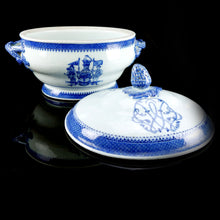Admiral ‘Hot ‘n Hot’ Hughes’s Tureen, 1780
- Regular price
- £1,100
- Sale price
- £1,100
- Regular price
-
- Unit price
- /per
Adding product to your cart
Width: 33.5cm (13.2in)
Chinese export porcelain. A large blue and white armorial lidded tureen decorated in the Fitzhugh pattern, so named for the design used on a service ordered by Thomas Fitzhugh, an East India Company official at Canton between 1786 and 1800. The present double-handled bowl bears the armorial of Admiral Sir Edward Hughes, Commander-in-Chief in the East Indies, 1778–83, viz, arms - a lion rampant, encircled by the Order of the Bath motto 'Tria Juncta in Uno’ (Three joined in one) over the fighting admiral’s personal motto, ‘Forward’; with supporters in the form of a Chinese archer and a Chinese official, all beneath the open helm of a knight and the Hughes crest - out of a naval coronet and arm embowed holding a scimitar. The lid decorated with a pineapple shaped finial and monograms.
Read more
Admiral Sir Edward Hughes (1716-1794) was a brave and honourable officer, who, though not blessed with a brilliant tactical ability, did adhere rigidly to the fighting instructions. He was known to his men as ‘Old Hot and Hot’ for his favouring of very hot food, in which he evidently freely indulged for his figure could only be described as rotund. He was born at Hertford, the son of an alderman, Edward Hughes, and of his wife, Elizabeth Chichele. He entered the navy in 1735 and was promoted lieutenant of the fireship Cumberland for his services under Admiral Vernon at Porto Bello in 1740. He was later with Mathews when he blockaded Toulon in 1744; under Boscawen at Louisbourg in 1758; and under Saunders at the taking of Quebec in 1759.
Hughes was appointed Commander-in-Chief in the East Indies in 1773 and after a quiet few years returned to England in 1778, only to be sent out again as rear-admiral of the blue, and as a knight of the Bath in 1779 with his flag the Superb (74). On the way he took Goree in West Africa from the French. In 1782-83 he fought five actions with Bailli de Suffren - the most tenacious French admiral of the period - in the Indian Ocean. At the at the Battle of Providien in April 1782 his centre became isolated, culminating in the massive loss of fifty-nine men killed and ninety-six wounded aboard his flagship alone. Next day Hughes brought his fleet to anchor and foiled Suffren’s plan of attack. However there followed a confusing episode in which Hughes refused a prisoner exhange with Suffren as he felt he did not have the authority. The British prisoners were then handed over to the Muslim ruler of Mysore Hyder Ali, which could only be regarded as a sadistic act on the part of the French admiral.

In these actions neither side took a ship nor achieved a decisive advantage, although de Suffren had the best of it strategically. Hughes was in fact by then on his third tour in India as his intended successor Admiral Sir Hyde Parker, 5th Bt (1714-1782) was lost with all hands in HMS Cato on his way out. When the war ended the following year Hughes returned home, and going up to London, met with the Home Secretary before enjoying a conference with George III and arranging the delivery to the Queen of a buffalo which he had brought back from India. Though immensely rich from prize money and other perquisites, he subsequently lived in unshowy retirement.








